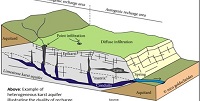|

|
|
Principal Aquifers by Rock Type – Carbonate Rocks
Rocks that are primarily composed of calcium carbonate constitute about 20 percent of the earth’s sedimentary rocks and they underlie about 40 percent of the land surface in the United States. These carbonate rocks consist of limestone and dolomite that contain groundwater in fractures and pore space which, in the year 2000, provided water at a rate of 5,840 million gallons per day from 16 principal carbonate-rock aquifers in the U.S. (Maupin and Barber, 2005). Despite their importance for water supply, many aspects of groundwater flow in carbonate aquifers are poorly understood.
(Aquifers & Geology- 16)
|
|

|
|
Principal Aquifers by Type - Unconsolidated Aquifers
Erosion and deposition are two earth processes that shape much of the surface and near surface of the Earth. Much of the Earth’s near-surface material consists of geologically recent deposits that are unconsolidated (loosely arranged or consisting of particles are not cemented together). Coarsely grained near-surface deposits are among the most important aquifers because they are an active part of the water cycle and because they generally yield water more readily than their consolidated equivalents. Most unconsolidated aquifers are composed of sand and gravel that was carried by water either in streams flowing from runoff or from melting ice, especially over the last three million years during continental glaciation. Learn more in this guided lesson with short-answer Discussion Questions.
(Aquifers & Geology- 16)
|
|

|
|
Principal Aquifers by Rock Types - Igneous and Metamorphic Rocks
Igneous and metamorphic rocks seem unlikely candidates for storing and moving water, and, from a primary porosity and permeability perspective, little groundwater moves in these rock types. There are, however, other factors (e.g., depositional modes) that complicate the general perception that these rock types are improbable aquifers. Learn more in this engaging reading lesson and answer the short Discussion Questions to stimulate critical thinking.
(Aquifers & Geology- 16)
|
|

|
|
Recharge Area vs Discharge Area
Groundwater recharge or deep drainage or deep percolation is a hydrologic process, where water moves downward from surface water to groundwater. Recharge is the primary method through which water enters an aquifer. Watch the MAGNET video and answer the questions that follow.
(Aquifers & Geology- 16)
|
|

|
|
Recharge Area for a Confined Aquifer
A recharge area is the place where water is able to seep into the ground and refill an aquifer because no confining layer is present. Recharge areas are necessary for a healthy aquifer. Watch the MAGNET video below and answer the questions that follow.
(Aquifers & Geology- 16)
|
|

|
|
Investigation of an Aquifer System
Find (in books or journals, or online) an aquifer system and describe its main characteristics. Look at the aquifer type, size, location, its geology, the source of water, its relation to other aquifer and surface water bodies, how the aquifer is used, how water levels (piezometric heads) changed in time, etc. Use less than 500 words (one page) of text.
(Aquifers & Geology- 16)
|
|
|
|